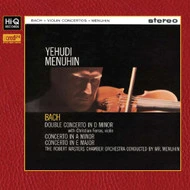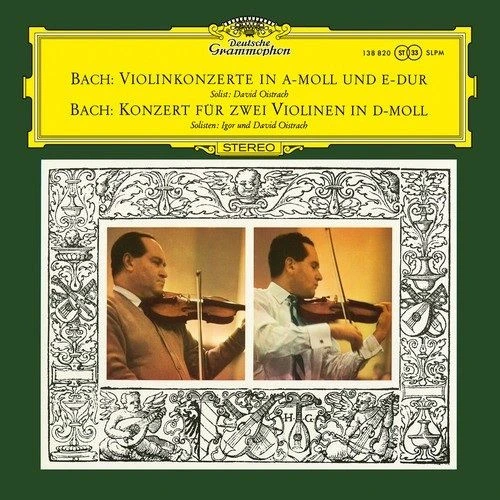 Click Here for Sound Samples!
Click Here for Sound Samples! Audiophile XRCD24 Mastered from the Original Analogue EMI Master Tapes!
Can Be Enjoyed On Any CD Player!
Yehudi Menuhin was a rich enigma: a gentle spirit tied to an implacable will: a perfectionist who loved amateurs and young beginners; an ascetic who relished down-to-earth pleasures. A visionary who got things done. An artist who believed the music he played to be, quite literally, a form of human healing, out of which we might make peace with ourselves. Menuhin didn't just play the violin. Rather he seemed to regard music as a kind of prayer made audible, and mellifluous. Nothing in the world was so natural, or so pleasurable. Nothing was more indispensable.
"Two of EMIs top people - producer Peter Andry and engineer Robert Gooch - recorded the music in 1958 and 1959 at Londons Kingsway Hall, the venue EMI, Decca, and other companies used for any number of fine recordings over the years... JVC, using their XRCD and K2 remastering and manufacturing processes, replicate it on disc about as well as I would imagine possible. They also got a wide stereo spread, yet without stretching the image too far beyond the speakers. Its a natural, transparent sound, the violin nicely integrated into the orchestral setting, with a modicum of depth, air, and ambient hall bloom adding to the feeling of realism... theres no denying how good it is, interpretively and sonically." - John J. Puccio, Classical Candor
Click Here to read the entire review!
His own abilities were deeply paradoxical: there was his immense faith in his musical gift; but he had a most beguiling sense of his own uncertainties and flaws. He was against the notion that says you cannot make music unless you make it perfectly. He took the view that it is music that perfects the artist. Not the other way around. Music for Menuhin was not about success, it was a life-support system.
The Violin Concerto in A minor, BWV 1041 has three movements, the Allegro or Allegro moderato, the Andante with an ostinato style theme, and the Allegro assai. In the Andante Bach uses an insistent pattern in the bass part that is repeated constantly in the movement. He focuses the variation in the harmonic relations. In the final movement Bach relies on bariolage figures to generate striking acoustic effects. The piece is a baroque concerto which is in ritornello form. This means that there is a main section that comes back in fragments in both the solo violin, piano and orchestral parts. This 'ritornello' can be found in the first movement up until bar 24.
The Concerto for 2 Violins, Strings and Continuo in D Minor, BWV 1043, also known as the Double Violin Concerto or "Bach Double", is perhaps one of the most famous works by J. S. Bach and considered among the best examples of the work of the late Baroque period. Bach wrote it between 1717 and 1723 when he was the capellmeister at the court of Anhalt-Köthen, Germany. In addition to the two soloists, the concerto is scored for strings and basso continuo. The concerto is characterized by the subtle yet expressive relationship between the violins throughout the work. The musical structure of this piece uses fugal imitation and much counterpoint. The concerto comprises three movements: Vivace, Largo ma non tanto, and Allegro.
The Violin Concerto in E major, BWV 1042 is a concerto for violin, strings and continuo in 3 movements: Allegro with ritornello, with an overall structure like that of a da capo aria; Adagio with a ground bass; Allegro assai with an overall structure of a rondo.
Recorded on 7-8 October 1958 and *8 July 1959 at the Kingsway Hall, London.
Features:
Mastered from the Original Analogue EMI Master Tapes!
Superior Audiophile XRCD24
XRCD24 is a standard "Red Book" CD and can be enjoyed on any CD player
Musicians:
Yehudi Menuhin, violin, conductor
Christian Ferras, violin
Robert Masters Chamber Orchestra


 Turntable Accessories
Turntable Accessories Headphone Accessories
Headphone Accessories Cable Accessories
Cable Accessories Vinyl Accessories
Vinyl Accessories Compact Disc Accessories
Compact Disc Accessories









